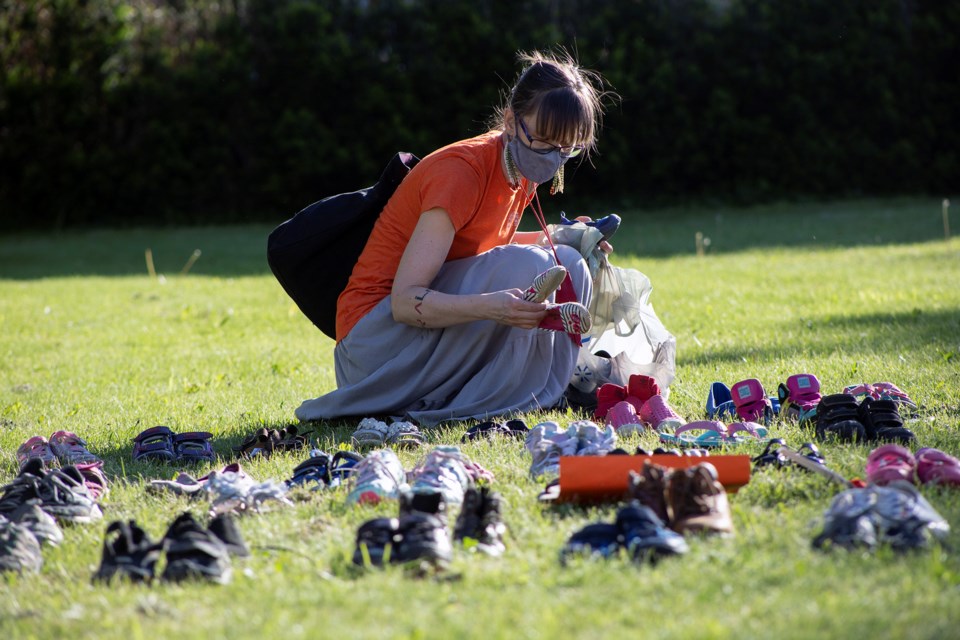The steps of Basilica of Our Lady Immaculate became a platform for local Indigenous survivors to share their grief Tuesday during a vigil in remembrance of the 215 children whose remains were recently found on the grounds of a former residential school in B.C. and for those yet to uncovered.
Over 300 people attended Tuesday’s vigil held on the steps at the base of the basilica, with the crowd gathered on the closed intersection of Norfolk and Macdonell streets.
The basilica was chosen as the site of the vigil to acknowledge the Catholic church's part in operating some of the residential schools and Indian day schools in Canada.
Hundreds of pairs of children’s shoes were displayed as part of the vigil on the lawn in front of the basilica, meant to represent the young lives lost.
Indigenous voices were given priority to speak at the event, including residential school survivors and their descendants.
Elder Maani Anna Cheesequay, who has lived in Guelph for over 40 years, addressed the crowd, speaking about the inter-generational trauma that has followed the residential school system.
“I used to go to the correctional centre and look at that institution and how they criminalized our people for hunting on our own homeland, for trying to find food for our grandchildren,” she said.
Speaking to GuelphToday after the vigil, Cheesequay said it has been known for years that children were buried in unmarked graves at various residential schools. The Truth and Reconciliation Commission has estimated 4,100 to 6,000 children died while attending those schools.
“I think the thing is, they are children. They are innocent children and now they are evidence,” she said.
Cheesequay said he was encouraged by the turnout and the raised level of awareness in the general population about the issue.
“I think it’s a beginning. It’s a big beginning for everybody. I think change is coming,” she said.
Tauni Sheldon is an Inuk elder originally from Nunavik who spoke during the vigil about the difficulties she sometimes faces when talking about her lived experience.
“How many times have I been asked or told that ‘it’s too much for me to hear’ or ‘can you change the subject?’ No. This is lived Indigenous truth. I can’t walk away from this and walk away from it for a day, because it’s there every day,” she said.
Speaking to GuelphToday after the event, Sheldon said non-Indigenous people could gain a lot of understanding by simply listening.
“How many times have we said to non-Indigenous people to come to our events, come feast with us, come see our dancing?” she said.
Connecting with her own culture has been an uphill battle her entire life.
“I was stolen the day I was born. I was apprehended as part of the sixties scoop. That’s why I am here in this area now,” said Sheldon.
She hopes to see more events like Tuesday’s vigil as more bodies are found and people gain a deeper understanding of the horrors of the residential school system and an effort made to correct them.
“It’s our peoples’ turn to speak out and have the truth told a little more,” said Sheldon. “There needs to be more action by all people.”
The local vigil was organized by three Indigenous youth, Hannah Geauvreau-Turner, Desiree Fekete and Xicotencatl Maher.
Geauvreau-Turner is living in Guelph and a full-time student at Conestoga College. She said it was important for her to stand up and share the effects that the system has had on her family.
“As a granddaughter of a residential school survivor and the daughter of an Indian day school survivor, I felt I needed to be here as a voice in honour of them,” she said. “My mother passed away when I was seven years old — she was in her thirties.”
“I feel very powerful to be here today and to be able to speak on their behalf,” she added.
Geauvreau-Turner told the crowd she has lost some connection to her own culture.
“I didn’t get to dance much at pow-wows because of life circumstances,” she said during her remarks.
Maher, who has been involved in a number of rallies over recent years, didn’t know what to expect in terms of numbers for the event, but was pleasantly surprised by the turnout of over 300 people.
“I am seeing numbers I have never seen before and I think it’s because people are really waking up to what is going on in Canada — and that is nice,” said Maher.
Maher said emotions were all over the map during the event.
“We are grieving but we are happy something is happening. It’s heavy — it’s like a funeral,” said Maher.
The shoes that were on display have been collected and will be donated HOPE House and distributed though it and some of its partner programs, said Geauvreau-Turner.
“The most important thing is we got more than 215 pairs of shoes for the children, so we made our goal in honour of those 215-plus children,” said Geauvreau-Turner.
